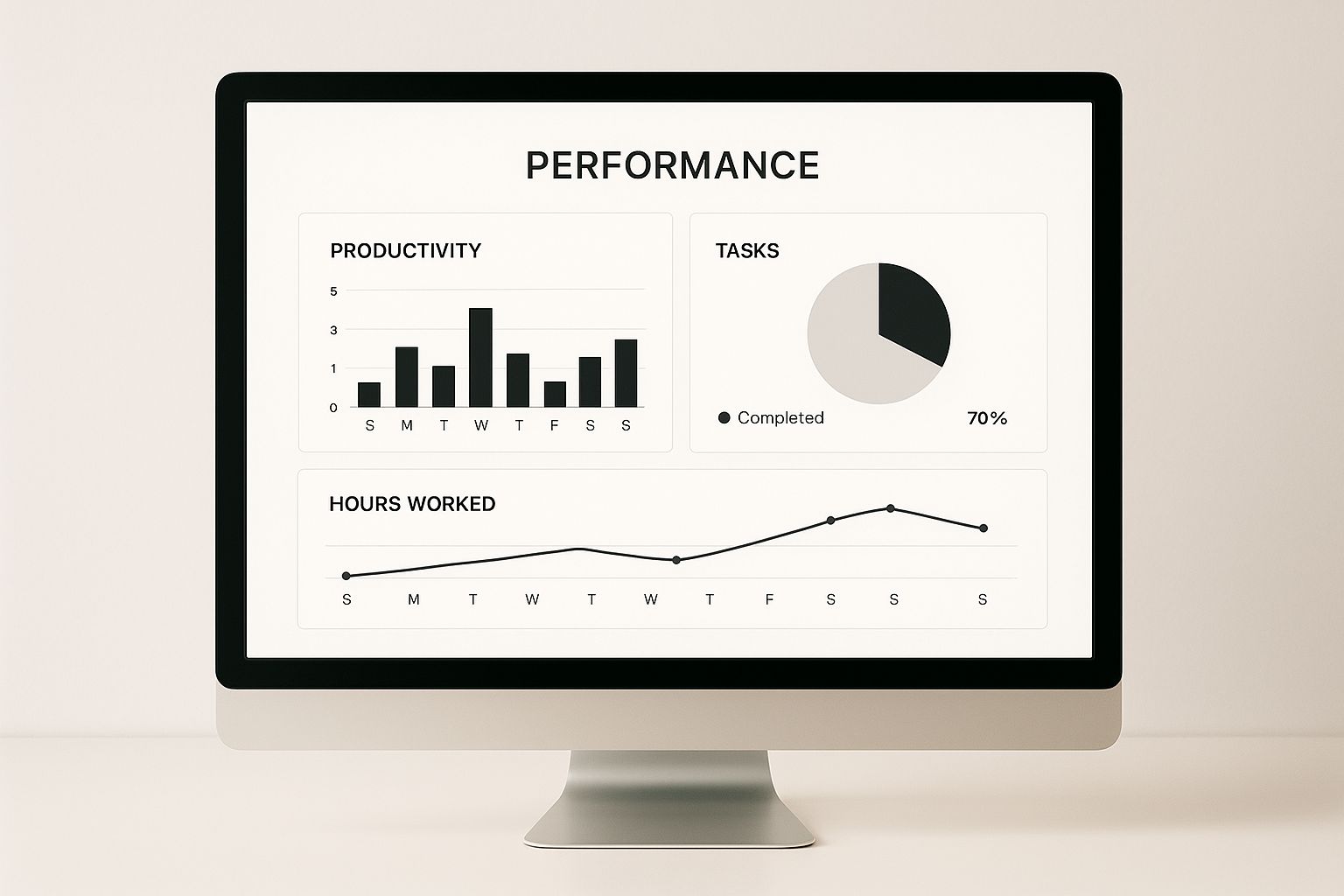If you're going to track your team's productivity, you need a solid game plan. It’s not about just watching the clock. A truly effective strategy is a mix of setting clear goals, picking the right metrics to measure, using the proper tools, and maintaining open, honest communication with your crew.
The real goal here is to shift your focus from simply monitoring activity to understanding actual output and how efficiently your business is running.
Why Smart Productivity Tracking Is a Game-Changer
It’s time to move past the old-school question of, "Are my guys actually working?" Smart productivity tracking isn’t about being a Big Brother; it’s about getting the clarity you need to run a better business, keep jobs profitable, and find ways to help your team succeed.
When you get this right, you build a culture of high performance and trust, not one of suspicion.
This shift is more important than you might think. Disengagement comes with a massive price tag. Did you know that 50% of workers globally are productive for less than five hours a day? That kind of lost productivity adds up, costing the global economy an estimated $8.9 trillion in lost GDP. If you want to dig deeper into this, there are some great strategies to improve team productivity that are worth a read.
To build a system that works, it's helpful to understand the core components.
Core Pillars of Effective Productivity Tracking
A successful tracking system is built on a few fundamental ideas. Getting these right is the key to creating a program that helps, rather than hinders, your business and your team.
Ultimately, a well-designed system gives you the insights to make smarter decisions, support your team's growth, and build a more resilient business.
Pinpoint Inefficiencies and Boost Profit
Good tracking is like a spotlight, illuminating the hidden bottlenecks in your operations. For any trade business, that might mean realizing a certain type of installation always runs over budget, or that your techs are spending too much time driving between jobs.
Once you can see these problems clearly, you can make smart adjustments to your scheduling, quoting, and routing based on real data, not just guesswork.
The point isn't to watch every single move. It's to understand workflow patterns, get rid of roadblocks for your team, and make sure their time on-site is as productive—and profitable—as it can be.
Recognize and Reward Your Best Performers
A fair and objective tracking system is also your best tool for spotting and rewarding your top technicians. Instead of relying on gut feelings, you can use hard data—like first-time fix rates or the number of jobs completed per week—to have meaningful conversations about performance.
This data-driven approach is a win-win:
- Fair Recognition: It gives you concrete proof to celebrate successes and back up decisions about raises, bonuses, or promotions.
- Targeted Training: It quickly shows you where someone might be struggling. Maybe an apprentice needs more hands-on training, or even a veteran tech could use a refresher on a new system.
- Improved Morale: When your team sees that their hard work is being measured and acknowledged fairly, it builds morale and fosters a healthy, competitive drive.
Picking the Right Productivity Tracking Method

Deciding how you're going to track your team's productivity isn't a minor choice—it shapes your daily workflow and the accuracy of the data you rely on. There’s no single "best" way for every trade business. The right fit really depends on your company's size, your budget, and how complex your day-to-day operations are.
If you’re running a smaller crew or just getting your business off the ground, sticking to manual methods can feel like the simplest option. Think daily check-ins, paper timesheets, or having your techs call the office between jobs. It's the old-school way, and for some, it works for a while.
The problem is, these methods are notoriously prone to human error. A technician gets busy and forgets to jot down a start time. Another misremembers how long a specific task actually took. Before you know it, you're trying to decipher illegible notes and dealing with a pile of inconsistent data that isn't helping you make smart business moves.
Shifting From Manual Logs to Automated Tools
As your business scales, the cracks in manual tracking start to look more like gaping holes. This is usually the point where owners start looking at software, which brings a huge advantage by automating data collection and giving you a real-time view of what's happening in the field.
The goal of technology isn't to replace your team's judgment but to eliminate the tedious administrative work that gets in the way of their real job—serving customers and completing high-quality work.
When you start exploring software, you'll find everything from basic time trackers to comprehensive field service management (FSM) platforms. Specialized employee productivity tools like Time Doctor, for instance, offer robust features for monitoring and analysis.
Adopting these tools is quickly becoming the industry norm. The employee monitoring software market is booming, projected to hit $7.61 billion by 2029. And it's not just a far-off trend; by next year, it's expected that more than 73% of employers will be monitoring their remote or hybrid teams.
Ultimately, jumping to an automated system cuts down on manual mistakes, frees up your admin's time, and gives you the clean, immediate data you need to truly optimize your business. You get to make decisions based on what’s actually happening out there, not on what’s reported hours or even days later.
Defining Productivity Metrics That Actually Matter
Are you just tracking activity for the sake of it? That's a classic mistake and a huge waste of time. The real goal is to measure the right things—the Key Performance Indicators (KPIs) that show you how productive and effective your field staff genuinely are. It's time to stop obsessing over 'hours worked' and start focusing on the tangible results that push your business forward.
When you nail down the right metrics, you get a clear, objective view of performance. No more relying on gut feelings. Instead, you'll have hard data showing who’s knocking it out of the park and where operational snags are slowing your team down. This data-driven approach helps you make much smarter decisions on everything from who gets the next big job to who needs a bit more training.
Think of it like a performance dashboard, where all your key data is visualized for quick, actionable insights.

As you can see, tracking isn't just about collecting numbers; it's about turning that data into a clear story about how your team is performing.
Essential Productivity KPIs for Field Staff
To truly get a handle on productivity, you need to look at both efficiency and quality. After all, what good is a technician who rushes through ten jobs a day if half of them result in angry callbacks and costly return visits?
The table below breaks down the KPIs I've seen make the most impact for trade businesses.
Focusing on these core metrics gives you a balanced and honest picture of your team's performance, moving beyond simple volume to measure true effectiveness.
A word of advice: don’t just set a single, flat benchmark for everyone. A senior tech with a decade of experience should have different targets than a new apprentice. Tailor your KPIs to match experience levels and specific job roles. This ensures your goals are both challenging and fair.
When you customize your metrics, you build a system that actually motivates your team instead of demoralizing them. When your crew sees that their individual contributions are being measured in a relevant way, they're far more likely to buy into the process and actively work on improving.
How to Implement Tracking Without Hurting Morale
Bringing in any new system to track performance can feel like walking on eggshells. Let's be honest, it’s where a lot of businesses get it wrong. They end up creating a "Big Brother" vibe that breeds resentment, not results. The secret isn't the tool you choose; it's how you roll it out. The single most important thing you can do is be upfront and crystal clear about why you're doing it.
The whole conversation needs to be framed around support, not surveillance. You have to connect the dots for your team, showing them how this helps them. Will it lead to fairer workloads? Will it create a clear, objective way to spot and reward the real top performers? That's the story you need to tell.
Build Trust Through Transparency
How your team perceives this change will make or break it. If they see it as a way to catch them messing up, you've already lost. Your communication has to be honest, consistent, and focused on the wins for everyone.
When you sit down to talk about it, try leading with points like these:
- "We want to use this to spot the bottlenecks that make your day harder, so we can actually fix them."
- "When we have accurate data on job times, we can finally make a solid case for hiring more help instead of running everyone into the ground."
- "This gives us a fair way to see who's consistently knocking it out of the park, so we can reward that effort properly."
This approach completely reframes the narrative. It’s no longer about catching people doing something wrong; it's about helping everyone do their jobs better.
The goal is to make your tracking system an ally for your team—a tool that validates their hard work, justifies the need for more resources, and helps streamline frustrating daily processes.
Focus on Efficiency, Not Just Activity
It's also critical to track the right things. Monitoring every tiny detail is a recipe for disaster. It can backfire in a big way.
A study of HCL Technologies, for instance, found that after introducing monitoring, employee productivity actually dropped by 8% to 19%. Why? The team spent more time in meetings and collaborated less. It’s a classic case of proving that tracking more hours doesn't automatically lead to better work. You can dig deeper into these employee monitoring statistics to see how this plays out across different fields.
Be clear about what is and isn't being tracked. Make it known that you're focused on job-related outcomes—things like job completion times and first-time fix rates—not personal activities. This builds the trust you need and helps position your system as a tool for a healthy, high-performing team.
Turning Productivity Data into Business Growth

Collecting data is one thing, but the real game-changer is turning those numbers into smarter business decisions. Once you know how to track employee productivity well, you've basically got a roadmap for growth. This is where your business starts to really get ahead.
For example, your data might show that technicians consistently lose 30 minutes of travel time between two specific neighborhoods. That’s not just a number; it’s a bright, flashing sign telling you to optimize your scheduling. By grouping jobs geographically, you can slash that wasted drive time and pack more billable hours into the day.
Or maybe you see a pattern of jobs being delayed because of a missing part. That's a clear signal to rethink your inventory. You can stock up on those commonly needed components so your team shows up ready to get the job done right the first time, every time.
From Numbers to Actionable Strategies
Productivity data gives you the power to stop guessing. It helps you move from hunches to evidence-backed changes, turning vague problems into concrete challenges you can actually solve.
Here’s how you can put that information to work:
Pinpoint Training Needs: If the data shows a certain technician is taking longer on specific types of installations, you can provide focused, hands-on training for that exact task. It’s far more effective than a generic workshop and gets them up to speed much faster.
Improve Performance Reviews: Feedback becomes a whole lot more constructive. Instead of "You seem a bit slow," you can have a real conversation: "I noticed your average time for this type of repair is 20% higher than the team's. Let's talk about what's going on and what support you need."
The data isn't for pointing fingers; it's for highlighting opportunities. It's about having constructive, evidence-based conversations that lead to real improvement and celebrating clear, data-backed wins with your team.
Beyond just tracking, you can also support your team's growth by creating an internal knowledge base to boost team productivity, which is another great way to translate operational improvements into business growth.
Tackling the Tough Questions About Productivity Tracking
Adopting a new way to track productivity is a big step, and it's completely normal for you and your team to have questions. Let's tackle some of the most common concerns head-on. Getting these answers right from the start is key to building trust and making the transition a success.
Is It Legal to Track My Team's Productivity?
Yes, in most places, it's perfectly legal to monitor employees using company-owned equipment during work hours, as long as it’s for legitimate business reasons. However, the laws around privacy can get tricky and vary quite a bit by location.
The golden rule here is transparency. Create a straightforward written policy that clearly explains what you're tracking and why. Make sure every single employee reads it and signs off. When in doubt, a quick chat with a legal professional can ensure you're compliant with all local and national rules, giving you total peace of mind.
How Can I Do This Without My Team Feeling Micromanaged?
This is probably the most important question to answer, and it all comes down to communication. You need to frame this as a tool for improvement, not for punishment. Explain that the goal is to boost efficiency, balance workloads fairly, and spot who’s doing incredible work—it’s not about watching their every move.
- Focus on Outcomes: Emphasize metrics like jobs completed, customer satisfaction scores, or first-time fix rates. Steer clear of more invasive measures.
- Share the Wins: When you use the data to praise a high-performing tech or to justify hiring another person to ease the workload, your team will see the real benefit. They'll understand it's about making their jobs better.
The secret is being open. When your team sees that tracking is there to help them succeed and make their work smoother, you’ll find they’re much more willing to embrace it.
What’s the Single Most Important Feature in Tracking Software?
For any business with technicians in the field, the most crucial feature is automated and accurate data collection that doesn't add more work to their plate. Your techs are busy solving problems for customers; they shouldn't be bogged down with admin tasks.
Look for tools that make their life easier. This means things like GPS to confirm they're at the right job site, automatic time logging when they arrive, and a dead-simple mobile app. A system that can automatically create job notes is a game-changer. It cuts out the manual data entry, prevents errors, and gives you clean, reliable information you can actually use to run your business better.
Ready to eliminate manual note-taking and get crystal-clear job logs automatically? Nora uses AI to turn your team’s voice notes, texts, and photos from WhatsApp into perfectly organized job records.



